The Tibetan Collection of the Staatsbibliothek zu Berlin
Tibet looks back on a long history of written culture. As early as the 7th century, the Tibetan script was developed in its present form. Even though writing was most likely introduced to organise administration – the Tibetan Yar-klungs dynasty was a major empire at the time – it quickly became one of the most important tools for spreading Buddhism. To this day, the reproduction of religious texts is considered extremely meritorious.
The book format was based on the palm format common in India at the time, the so-called pothi format, known as dPe-cha in Tibet. This is a landscape format in which the leaves are much wider than they are high and are perforated several times on the upper long side. Threads were pulled through these holes to join the individual leaves together to form a book. In Tibet, this practice was first adopted, but since the 14th century, it has been replaced by drawn circles. To organise the loose leaves, the Tibetans used a different technique. The pile of leaves was placed between two book covers and the whole was wrapped with a cloth to hold it in place. Traditionally, wood was used for the book covers, often with very rich decorations. Modern publications in this format usually use thick paper or cardboard for the covers. The cloth wrapping also serves to protect the texts from climatic effects and pests.

Waddell 1 280r: example of imitation palm leaf lacing
Tibetan texts are available in different scripts. It is helpful to first distinguish between dBu-can and dBu-med scripts. While important Buddhist texts were primarily written in dBu-can, dBu-med was mainly used for non-canonical Buddhist writings, treatises and biographies.

Waddel 148 2v: Example of dBu-med
Block prints mostly use dBu-can fonts. Block printing is an East Asian cultural technique that was developed in China. The special feature of this technique is that the text is first transferred mirror-inverted onto a flat wooden plate, the later printing block, and then the non-text areas are cut out so that the text remains as a relief. Cutting is very time-consuming and requires a high degree of precision. Once the printing block is ready for use, it can be used for a very long time. In printing, which is actually rubbing, the paper is placed on the printing block moistened with the dye, often ink, and then rubbed with pressure on the back so that the text is transferred to the paper. Through many years of use, the plates wear down and characteristic signs of wear occur, e.g., widening and increasing blurring of the letters or even the breaking off of some filigree parts of the letters. This is then clearly visible in the printed work. The first block prints in Tibetan script were produced in the Tangut Empire (Xixia, 1038-1226). During the Yuan Dynasty (1279-1368), printing of Buddhist texts in particular was intensified. As a result, the technique of block printing became more widespread in Tibet, and in the 17th and 18th centuries, corresponding printing works were established in the vicinity of the large monasteries. Through the mutual cultural influence of Tibet and Mongolia, especially through the spread of Tibetan Buddhism in this region, block printing also reached Mongolia. There, texts were printed in both Mongolian and Tibetan language and script.
Today, texts are produced almost exclusively by means of offset printing, both as bound books and in block printing format. Many of the modern publications in dPe-cha format originate from the exile communities in India. Buddhist texts in particular are produced there in this format, following the tradition.

Waddell 39a: Example of a block print
The diversity of Tibetan publication forms and formats is also reflected in the collection of the Staatsbibliothek zu Berlin. Manuscripts as well as block prints and modern prints are kept there, along with newspapers, periodicals and special materials such as microforms. The pre-modern holdings comprise about 6,700 titles, the constantly-growing modern collection, more than 19,500 titles (as of September 2021).
As a result of the political situation in Tibet, modern publications are sourced from widely-dispersed markets. In addition to the Tibet Autonomous Region in the People’s Republic of China, Northern India plays a particularly important role. The Tibetan exile community there – especially in the region around Dharamsala – publishes an enormous variety of modern and traditional titles. Besides current Buddhist publications, there are reprints of important classical works as well as contemporary Buddhist commentaries. Another important genre is modern Tibetan literature, which often recounts the experiences of exile and the loss of the homeland. Outside the Tibet Autonomous Region and Northern India, there are still some smaller markets in various Chinese provinces where Tibetans make up a certain proportion of the total population, for example, in Qinghai. There are also individual publishing houses in other regions of China that publish Tibetan-language titles.
The history of the Tibetan collection
Tibetan manuscripts and block prints were already acquired by the Royal Library before the establishment of the special departments responsible for the collection today (Oriental and East Asian Department), i.e., before 1919. Holdings dating back to this time can be identified by shelf marks beginning Ms. or. fol. as well as Ms. or. oct. and Ms. or. quart (folio, quart, octav). Ms. stands for manuscripta, or. for orientalia and fol., quart. and oct. for the format. Block prints were also recorded under the Ms. note. After 1945, the shelfmark designation Hs. or. was started and continued until today. Already during the 19th century, the Tibetan collection grew continuously. Due to the heterogeneous acquisition situation, objects of the most diverse materials, ages and subject areas can be found.
During the Second World War, a large part of the collection’s pre-modern holdings were packed up and relocated from Berlin to remote areas hardly affected by wartime activities. Due to border changes after the war, some of these areas are now in Poland. This can be seen particularly well in the Tibetica collection of Eugen Pander (1854-1893). Among other things, he acquired numerous Tibetan titles that came into the possession of the library. In this specific case, the objects first came to Ksiaz (formerly Fürstenstein) and from there to Krzeszów (formerly Grüssau). From there, after the end of the war, the book crates were brought centrally to Krakow (Poland) into the Biblioteka Jagiellońska, where they are still kept today. Around 865 titles are kept there, of which about 300 are Tibetan under the shelf mark “Pander” and another 60 under the shelf mark “Pantheon“.
Information on this and on other collections affected by the removals can be found in the thematic portal on the Berlin-Krakow project. As part of this project, the objects were digitised by 2014 and made accessible online in the Digital Collections of the Staatsbibliothek zu Berlin. There they can be found with the search key “verlagerte Bestände digital Ostasiatica.”
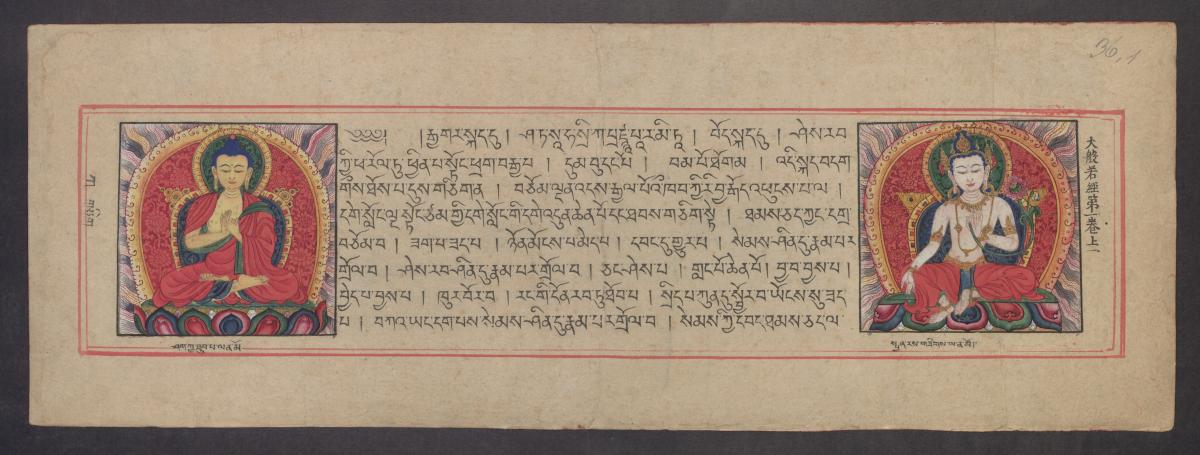
Pantheon 26: Example from the Pander collection
With the German division, further parts of the holdings were located in the territory of the (Eastern) German Democratic Republic (GDR) and the (Western) Federal Republic of Germany (FRG). The objects in the GDR were transferred after the war to the Öffentliche Wissenschaftliche Bibliothek, since 1954 Deutsche Staatsbibliothek (DSB). The parts of the collection in the later Federal Republic were collected in Marburg in particular, and also catalogued there. After the completion of the new library building at Potsdamer Straße in 1978, at that time West Berlin, these holdings were brought back to Berlin.
In addition, so-called (SSG) Sondersammelgebiete (special subject collection areas) were established in the Federal Republic by the (DFG) Deutsche Forschungsgemeinschaft (German Research Foundation). The aim of these collecting activities was to make at least one copy of every relevant scientific and scholarly work available in Germany. The SSG began their work in 1949. Tibet-related literature was collected in “SSG 6.25 East and Southeast Asia” at the Berlin State Library. Thematically, mainly the humanities and social sciences were covered. Thanks to the financial support of the DFG, an extensive collection of Tibetan literature was built up over the next decades.
Current, original-language specialist literature was also procured in the GDR. This was mainly done through exchange agreements with various institutions in the respective countries. Tibetica were first delivered to the Deutsche Staatsbibliothek again in 1957. They entered the collection through the help of today’s Mongolian National Library in Ulaanbaatar.
After the reunification of the GDR and the FRG in 1990, the two state libraries were merged and the collections – which had been built up under very different conditions – were brought together.
In 2014, the DFG reformed the special subject collection structure which is characterised, among other things, by prioritising digital media formats in procurement. The SSG were successively replaced by the FID Fachinformationsdienste (specialised information services for science). Since 2016, the State Library in Berlin has been responsible for the FID Asia, which includes the digital platform CrossAsia. The collection activities of the FID Asia have changed only slightly in terms of content compared to the SSG; collections are still mainly on topics in the humanities and social sciences.
Collections
The entire pre-modern collection of Tibetica is listed in the portal “Orient Digital.” There, a compilation of all the Tibetica listed. In addition, all digital copies can be searched in the “Digitised collections” of the Staatsbibliothek zu Berlin. All modern titles can be searched in the OPAC of the Staatsbibliothek, the StabiKat. In the following, the extensive pre-modern holdings in particular will be presented in more detail. These are largely characterised by important individual collections. Some of them are presented below in excerpts. Information on catalogues can be found at the end of the thematic portal under “Sources”.

L. A. Waddell
Waddell Collection
Laurence Austine Waddell (1854-1938, also: Lawrence Augustine) was a British military surgeon and orientalist. He studied medicine at the University of Glasgow and in 1880 joined the Indian Medical Service, a branch of the British military that also performed civilian duties. During his military service he served in India for nearly twenty years, first between 1885 and 1895 in the Darjeeling district and later, from 1896 to 1902, as Professor of Chemistry and Pathology at Calcutta Medical College. He took part in various military campaigns, including the British Tibet campaign (Younghusband military expedition, 1903-1904). During this campaign he collected various objects and manuscripts for the British Museum and the India Office Libraries in London among others. After his return to Britain, he was professor of Tibetan at University College, London, from 1906 to 1908. Later he turned to a new field of interest: ancient Mesopotamia and its relations with India. During his time in India, he also became strongly interested in Buddhism and visited numerous places related to early Buddhism, for example, Pāṭaliputra or Bodhgayā. He collected Buddhist art from Gandhāra and acquired literature for his private collection and the libraries in Calcutta, London, Oxford and Cambridge.

Waddell 1 36r: Example of an illustration of the gZer-mig
The Waddell Collection in the Staatsbibliothek today comprises 429 titles and documents under the shelf marks Wadd. 1-Wadd. 179. It contains part of his private library. Due to the variety of Waddell’s interests, the objects cover a wide range of topics. Apart from some important works, however, the bulk of the collection consists of more easily available texts such as Dhāraṇīs. A very rare work is a manuscript of the gZer-mig (Wadd. 1, Wadd. 1a). The gZer-mig relates the life story of the mythical founder of Bon, the pre-Buddhist religion of Tibet, gShen-rab Mi-bo-che. The numerous miniature paintings in the text are particularly memorable. In addition, various grammatical works belong to the collection, such as a block print of the Sum-cu-pa (Wadd. 126a). Several handwritten astronomical tablets, as well as a total of 17 unique charters, missives and decrees are also part of the collection. The collection was described by Dr. Schuh in the catalogue “Sammlung Waddell der Staatsbibliothek Preußischer Kulturbesitz Berlin“; 275 titles are now available in digital form.
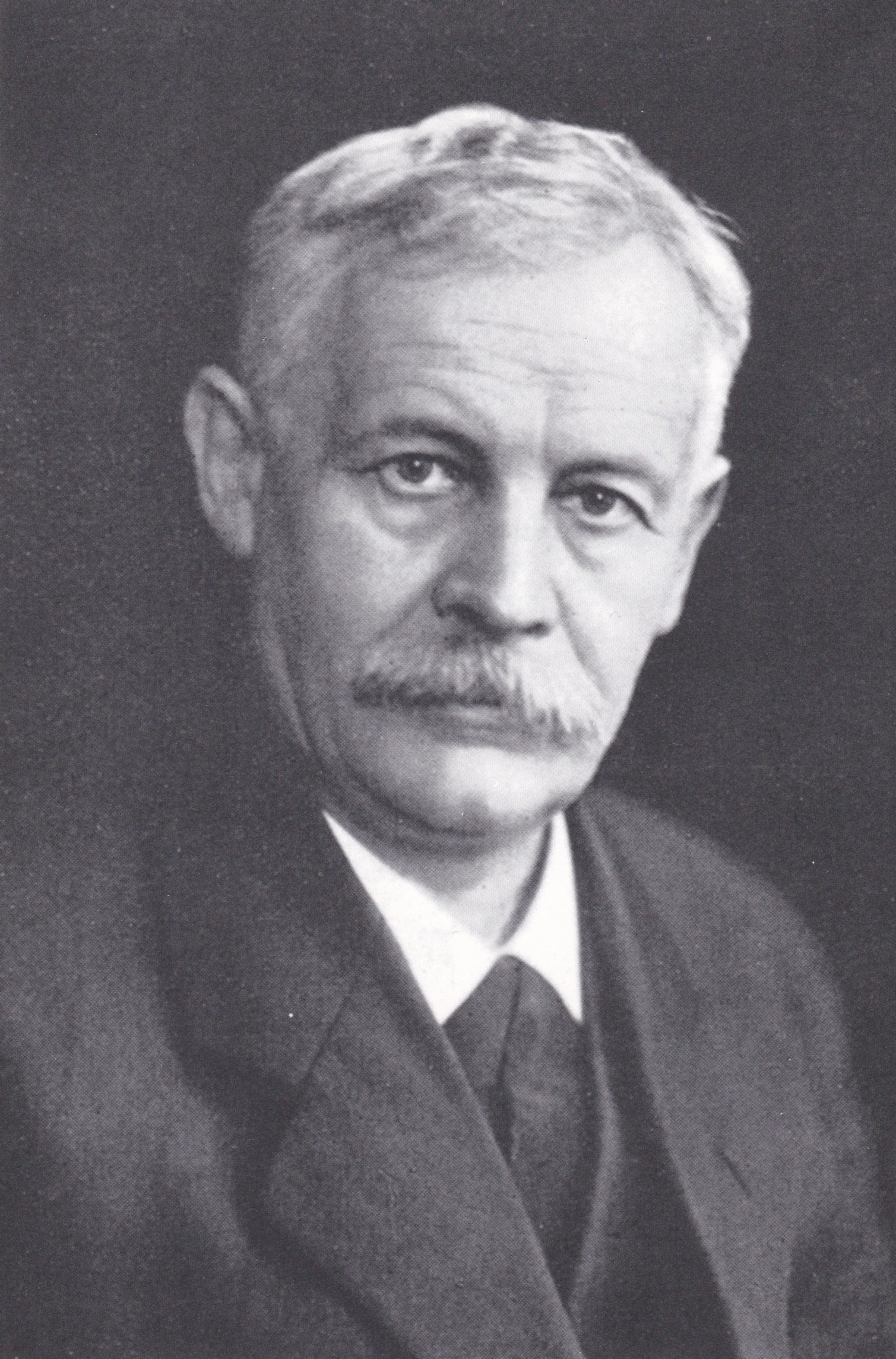
August Hermann Francke
Collection Francke
August Hermann Francke (1870-1930) was a member of the Herrnhuter Brüdergemeine (Moravian Church) and was called to missionary service in British India in 1895. He began this service the following year and spent several years (1899-1904) in Khalatse (Ladakh, India). He learned Tibetan and in the years that followed, apart from missionary work, he was mainly involved in scientific expeditions in the Himalayan region, for example, in 1909/1910, on the Tibetan western border on behalf of the British government. In 1914, he was sent to Ladakh again and arrested there by the British as an “enemy alien” because of the World War that had begun. During his imprisonment, his fellow inmate F. Otto Schrader (1876-1961) taught him Sanskrit. After his release, he was initially employed as an interpreter in Serbia and only returned to Germany in 1919. Once there, he resumed his scholarly activities, beginning with an edition project on the Berlin gZer-mig texts (see Waddell Collection, Wadd. 1). In 1922, he habilitated at the philosophical faculty of the Berlin University with a thesis on the Bon. He taught there as an associate professor from July 1925 until his death in 1930. Francke had a wide range of interests, especially in pre-Buddhist Bon religion; he also worked archaeologically. In addition, the musically-gifted Francke also devoted himself to Tibetan music, among other things, in an attempt to adapt church songs
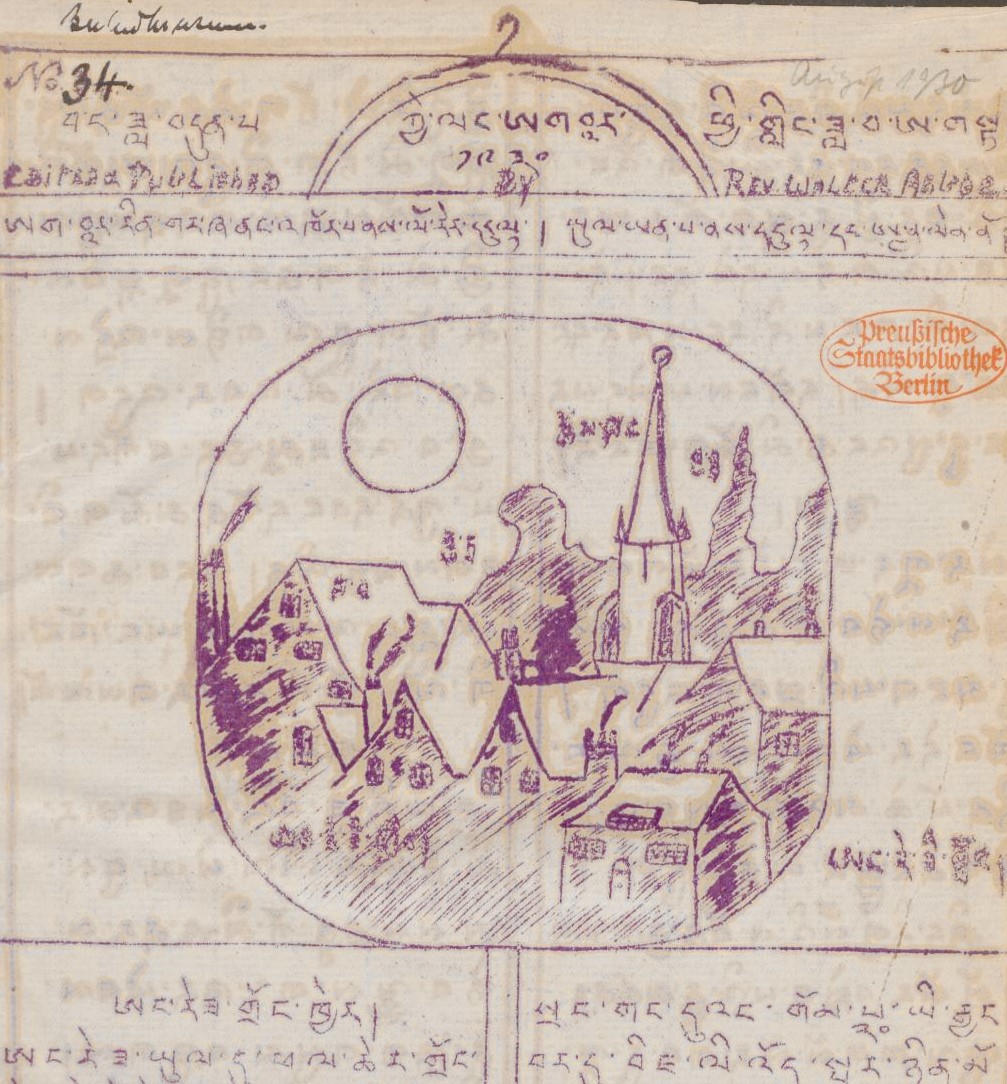
Libri tibetici 13: Herrnhuter Druck from Kyelang
The Francke Collection in the Staatsbibliothek is quite extensive and is maintained by various departments. A handwritten estate of Francke is now in the Manuscript Department. These are mainly personal records. In addition, there are the so-called Herrnhuter Drucke (Moravian Prints) with the shelf marks Libri tibetici 13-39, 412-69, 71, 74, 82. The special feature of this part of the collection is that although the titles come from Francke’s possession, the majority were not produced by him. There are numerous works by his Herrnhuter confreres, Heinrich August Jäschke (1817-1883) and August Wilhelm Heyde (1825-1907) as well as others. These are translations, including ecclesiastical literature, as well as prints of the missionaries. It can be assumed that the documents were created at one of the mission seats. A third part is formed by the Tibetica of the Museum of the Mačica Serbska, a scientific society of the Sorbs which until today is dedicated to the transmission of knowledge about the Sorbian culture. For this purpose, Francke himself prepared a catalogue which was published in 1907 in a local paper, the Bautzner Anzeiger. 43 objects can be assigned to this collection (Hs. or. fol. 4227-4241; Hs. or. quart. 1881-1883, 1885-1892, 1894-1895; Hs. or. oct. 3513-3515; Libri tibetici 56a, 72-81, 83-84). They were first given to the Museum of the Mačica Serbska and only later came to Berlin. Some of them are copies of Tibetan originals made on site. In terms of content, this collection is extremely diverse, covering a wide range of topics from documents and Buddhist texts to historical writings. The museum’s collection does not include the Tibetica with the shelf marks Hs. or. fol. 4219; Hs. or quart. 1791, 1794-1796, 1798-1799, 1884, 1893, Hs. or oct. 2948, 2974, 3273-3281, 3506 and one object without shelf mark. They come from Francke’s estate and are composed of texts collected and used by him. However, they are similarly diverse in content. Of particular interest is the object with the signature Mus. O.75228. It is a collection of Tibetan melodies, created by Francke and today kept in the Music Department of the Staatsbibliothek. An overview of the Francke Collection can be found in “August Hermann Francke und die Westhimalaya-Mission der Herrnhuter Brüdergemeine.”

Walther Heissig
Collection Heissig
Walther Heissig (1913-2005) was an Austrian mongolist. After completing his doctorate on “Das Gelbe Vorfeld: die Mobilisierung der chinesischen Außenländer,” he was stationed in East Asia for several years during World War 2. During this time, he gathered the objects of his collection which was purchased by the Staatsbibliothek Preußischer Kulturbesitz. After a so-called Umhabilitation (second habilitation) in Bonn in 1957 he received a professorship there. There, he founded the Central Asian Seminar in 1964 and established the Sonderforschungsbereich Zentralasien from 1969-1989. His initiative led to the founding of the Permanent International Altaistic Conference (PIAC).
Although Heissig’s academic work is primarily in the field of Mongolian studies, he also collected numerous Tibetica during his time in China. They are listed under the shelf marks Hs. or. 1941-2279 and comprise a total of 454 texts. There is no further information about their provenance. The majority of the manuscripts and block prints were produced in the immediate vicinity of the Qing court, but there are also some that may have been produced in Mongolia or Tibet. This can be seen mainly in the quality of the paper, the type of writing, and the pagination. The collection consists primarily of Buddhist texts, such as wish prayers, teachings, and texts of the Buddhist canon. The Heissig collection has been catalogued several times. In addition to the complete catalogue “Schriften aus dem Umfeld des Kaiserhofs der Qing-Dynastie, Bestand der Staatsbibliothek zu Berlin – Preußischer Kulturbesitz,” the catalogues of Meisezahl provide important information on the illustrations of the individual titles.

Erich Haenisch
Haenisch Collection
Erich Haenisch (1880-1966) studied Chinese, Manchurian and Mongolian at Berlin University (now Humboldt Universität). After completing his dissertation with the title “Die chinesische Redaktion des Sanang Setsen, Geschichte der Ostmongolen, im Vergleiche mit dem mongolischen Urtexte” in 1903, he worked from 1904 onward as a language teacher at the military academy in Wuchang and travelled through large parts of China during this time. After his return to Germany in 1911, he habilitated on the subject of “Der Aufstand des Wu San-kuei” and held several professorships in Germany (Berlin 1920-1925 as associate professor), also 1932-1946; Leipzig 1925-1932; Munich 1946-1952). He travelled to China and Mongolia several times. During his last trip to China, in 1936, he studied Sino-Manchurian files in various Beijing archives. His main research interests included Yuan and Qing-period China. One of his main scientific works was the reconstruction of the Mongolian wording of the Secret History of the Mongols (Mongγol-un niγuča tobčiyan) from the Chinese transcription in 1937.
In 1929, he acquired a collection of Tibetan block prints in Beijing for the then Preußische Staatsbibliothek. This was a specific purchase for the library. It was common at the time for libraries to commission scholars, travellers and diplomats to make acquisitions for them locally. In this case, it was a print of all the printing blocks from the Songzhu-si monastery in Beijing, as well as some block prints which – as can be seen from the printing note – originally came from other monasteries in Beijing. This collection can be found under the shelf mark “Tibetische Blockdrucke.” It mainly contains Buddhist texts, but also provides information about the development of Tibetan Buddhism in the Chinese heartland. In addition, there is valuable materials of the Qing dynasty for research. The collection was compiled in the four-volume catalogue “Tibetan Manuscripts and Block Prints,” Volumes 1, 2, 3, 4, by Prof. Dr. Taube.
Explored Works
Below will be introduced some explored works. They came into the library as a unit of content.
Rin-chen gter-mdzod chen-mo
The Rin-chen gter-mdzod chen-mo (Hs. or. 778) is a 63-volume collection of religious texts attributed to the Nying-ma school. They are mainly treasure texts (gTer-ma). gTer-ma are religious texts which, according to legend, were hidden in various places in Tibet by Padmasambhava who is said to have brought Buddhism to Tibet. They remained there until they were rediscovered during the second spread of Buddhism (from the 11th century). Whoever found such a text was called gTer-ton. As a rule, gTer-ton were Buddhist scholars. Treasure texts can be found in real life and also during meditation. They are especially common in the Nying-ma tradition, which is based on Padmasambhava’s translations of Buddhist texts. The collection of texts was compiled by Kong-sprul blo-gros mtha’-yas (1813-1899). He was an important Buddhist scholar who was also a founding figure of the Ris-med movement. The aim of the movement was to collect texts of rare lineages and to preserve them. It also aimed to overcome competition between the major schools of Buddhism. Kong-sprul blo-gros mtha’-yas collected numerous treasure texts of the Nying-ma tradition which were already rare at that time, rearranged them and compiled the Rin-chen gter-mdzod chen-mo. The significance of the compilation lies in the heterogeneity of the individual texts, which belong to different lines of transmission within the Nying-ma traditions. The Rin-chen gter-mdzod chen-mo has been intensively explored, using the Berlin copy as an example within the framework of the Verzeichnis der Orientalischen Handschriften in Deutschland (VOHD), where it is accompanied by extensive introductory texts (Vol. 10, Vol. 11, Vol. 12, Vol. 13, Vol. 14, Vol. 15).
The acquisition of the text collection came about in 1965 through the mediation of the German Embassy in Kathmandu (Nepal).
Peking Kanjur
The Tibetan collection of the Staatsbibliothek zu Berlin also contains a copy of the Peking Kanjur. It is a 108-volume handwritten copy of the Wanli Kanjur (printed in Beijing in 1680). The Kanjur (bKa’-‘gyur) is one of the two collections of authoritative Buddhist texts recognised by all Buddhist schools. It consists of three parts: the vDul-ba (Vinaya texts), mDo (sutras) and rGyud (tantras). The arrangement and the texts contained are not identical. They vary according to the place of compilation. The production of a Kanjur was very elaborate and costly, which is why they were usually donated by wealthy persons. The printing of the Wanli Kanjur (1606-1607) was donated by the then Chinese Emperor Wanli (1563-1620). The printing plates of the Yongle Kanjur, which had already been produced in 1410, were used. Wanli had the heavily-damaged printing blocks of the original set reconstructed with the help of an earlier printing of the Yongle Kanjur. The volumes of the present copy are equipped with painted book covers as well as painted book cuts. A catalogue called Verzeichnis der Tibetischen Handschriften is available for this Kanjur edition. Individual volumes have already been digitised.
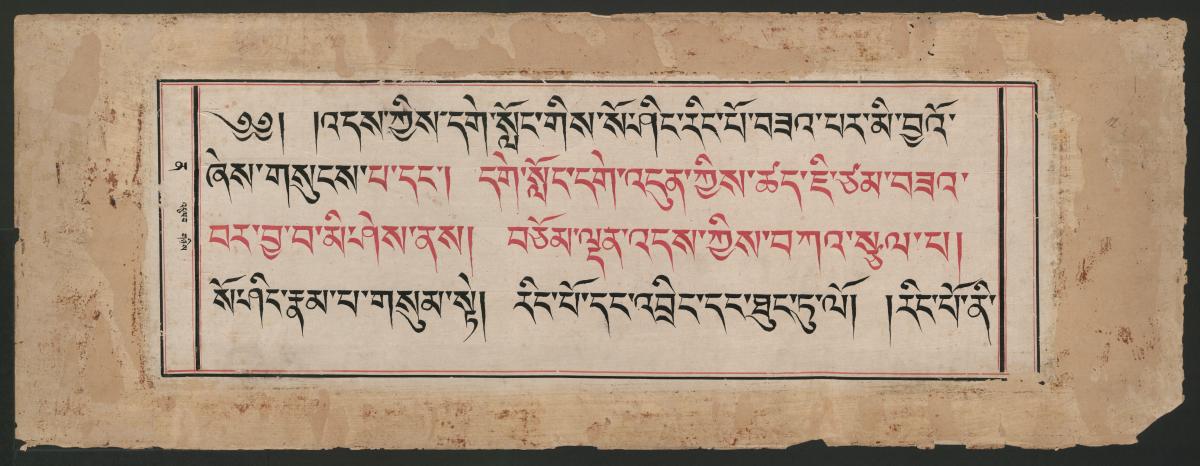
Peking Kanjur 12: Title
The acquisition of the 1889 Berlin copy of the Peking Kanjur from the Yonghe gong monastery in Beijing was arranged by Max von Brandt (1835-1920), who had spent a long career in diplomatic service in East Asia.
Gangs-ljongs sman-rtsis rig-mdzod chen-mo
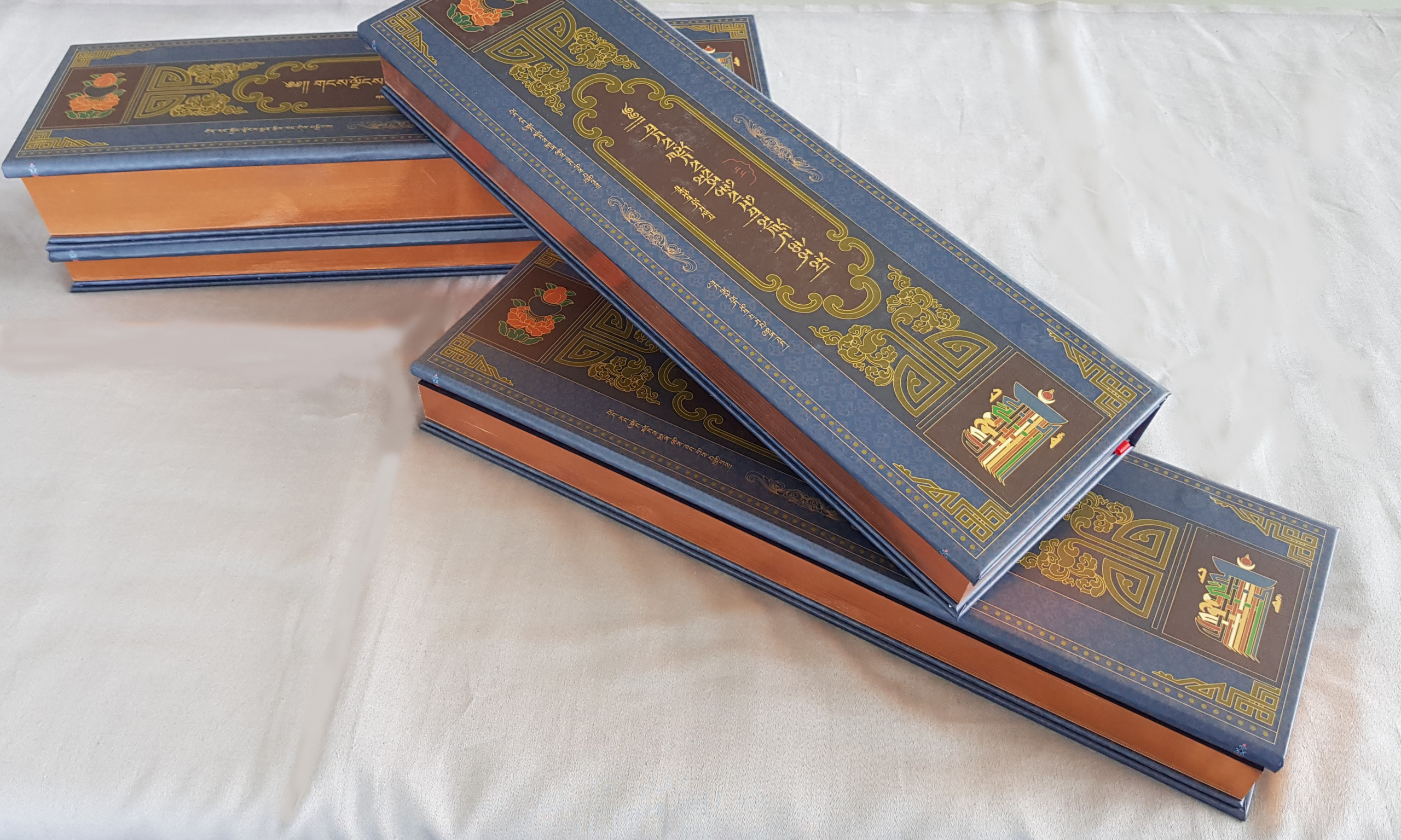
Gang-ljongs sman-rtsis rig-mdzod chen-mo
An outstanding object in the modern collection is a donation of facsimiles published by the sMan-rtsis-khang, an institute for Tibetan medicine and astrology in Lhasa. It is a 130-volume set of important texts on medical and astrological topics. It was published in 2016 to mark its centenary. Preparations for the compilation of the text collection began in 2006 and in the following years, under the guidance of Mr Yum-pa, the director of the institution, some 700 rare medical and 800 astrological texts were collected from all over Tibet. Of these, 130 texts were selected for publication. In each volume, there is a detailed preface with information on the facsimile text contained. The volumes can be found via the StabiKat OPAC of the Staatsbibliothek under the series title Gang-ljongs sman-rtsis rig-mdzod chen-mo.
Sources
Catalogues of featured collections
::: Beckh, Hermann (1914): Verzeichnis der tibetischen Handschriften der Königlichen Bibliothek zu Berlin. Kanjur (Bkah Hgyur). Berlin: Behrend (Die Handschriften-Verzeichnisse der Königlichen Bibliothek)
::: Taube, Manfred (1966): Tibetische Handschriften und Blockdrucke. Teil 1. Wiesbaden: Steiner (Verzeichnis der orientalischen Handschriften in Deutschland Tibetische Handschriften und Blockdrucke, Bd. 1)
::: Taube, Manfred (1966): Tibetische Handschriften und Blockdrucke. Teil 2. Wiesbaden: Steiner (Verzeichnis der orientalischen Handschriften in Deutschland Tibetische Handschriften und Blockdrucke, Bd. 2)
::: Taube, Manfred (1966): Tibetische Handschriften und Blockdrucke. Teil 3. Wiesbaden: Steiner (Verzeichnis der orientalischen Handschriften in Deutschland Tibetische Handschriften und Blockdrucke, Bd. 3)
::: Taube, Manfred (1966): Tibetische Handschriften und Blockdrucke. Teil 4. Wiesbaden: Steiner (Verzeichnis der orientalischen Handschriften in Deutschland Tibetische Handschriften und Blockdrucke, Bd. 4)
::: Schuh, Dieter (1981): Sammlung Waddell der Staatsbibliothek Preußischer Kulturbesitz Berlin. Stuttgart: Steiner (Verzeichnis der orientalischen Handschriften in Deutschland Tibetische Handschriften und Blockdrucke, Bd. 8)
::: Meisezahl, R. O. (1984): Tibetische Handschriften und Drucke, vornehmlich chinesischer Herkunft, in der Staatsbibliothek (Preussischer Kulturbesitz). In: Acta Indologica, S. 145–346
::: Meisezahl, R. O. (1988): Tibetische Handschriften und Drucke, vornehmlich chinesischer Herkunft, in der Staatsbibliothek (Preussischer Kulturbesitz) zu Berlin. Teil II. In: Oriens, S. 154–239
::: Schwieger, Peter (1990): Die mTshur-phu-Ausgabe der Sammlung Rin-chen gter-mdzod chen-mo. Bände 1 bis 14. Stuttgart: Steiner (Verzeichnis der orientalischen Handschriften in Deutschland Tibetische Handschriften und Blockdrucke, Bd. 10)
::: Schwieger, Peter (1995): Die mTshur-phu-Ausgabe der Sammlung Rin-chen gter-mdzod chen-mo, nach dem Exemplar der Orientabteilung, Staatsbibliothek zu Berlin – Preussischer Kulturbesitz, Hs or 778,. Bände 14 bis 34. Stuttgart: Steiner (Verzeichnis der orientalischen Handschriften in Deutschland Tibetische Handschriften und Blockdrucke, Bd. 11)
::: Schwieger, Peter; -Ortwin (1999): Die mTshur-phu-Ausgabe der Sammlung Rin-chen gter-mdzod chen-mo, nach dem Exemplar der Orientabteilung, Staatsbibliothek zu Berlin – Preussischer Kulturbesitz, Hs or 778,. Bände 34 bis 40. Stuttgart: Steiner (Verzeichnis der orientalischen Handschriften in Deutschland Tibetische Handschriften und Blockdrucke, Bd. 12)
::: Everding, Karl-Heinz (2008): Die mTshur-phu-Ausgabe der Sammlung Rin-chen gter-mdzod chen-mo, nach dem Exemplar der Orientabteilung, Staatsbibliothek zu Berlin – Preussischer Kulturbesitz, Hs or 778,. Bände 52 bis 63. Stuttgart: Steiner (Verzeichnis der orientalischen Handschriften in Deutschland Tibetische Handschriften und Blockdrucke, Bd. 14)
::: Schwieger, Peter (2009): Die mTshur-phu-Ausgabe der Sammlung Rin-chen gter-mdzod chen-mo, nach dem Exemplar der Orientabteilung, Staatsbibliothek zu Berlin – Preussischer Kulturbesitz, Hs or 778,. Bände 40 bis 52. Stuttgart: Steiner (Verzeichnis der orientalischen Handschriften in Deutschland Tibetische Handschriften und Blockdrucke, Bd. 13)
::: Arslan, Saadet (2011): Die mTshur-phu-Ausgabe der Sammlung Rin-chen gter-mdzod chen-mo, nach dem Exemplar der Orientabteilung, Staatsbibliothek zu Berlin – Preußischer Kulturbesitz, Hs or 778. Gesamtindex. Stuttgart: Steiner (Verzeichnis der orientalischen Handschriften in Deutschland Tibetische Handschriften und Blockdrucke, Bd. 15)
Further readings
::: Verzeichnis der Panderschen Sammlung 1890 (1890). [Berlin]
::: Bauer, Wolfgang (1967): Erich Haenisch (1880-1966). In: Zeitschrift der Deutschen Morgenländischen Gesellschaft, Jg. 117, H. 2, S. 205–210
::: Erich Haenisch in memoriam (1880-1966) (1968). In: Oriens Extremus, Jg. 15, H. 2, S. 121–122
::: Walravens, Hartmut; Taube, Manfred; Hahn, Michael; Voigt, Wolfgang; George, Dieter; Feistel, Hartmut-Ortwin (1992): August Hermann Francke und die Westhimalaya-Mission der Herrnhuter Brüdergemeine. Eine Bibliographie mit Standortnachweisen der tibetischen Drucke. Stuttgart: Steiner (Verzeichnis der orientalischen Handschriften in Deutschland, Supl.-Bd. 34)
::: Walravens, Hartmut (Hg.) (2012): Walther Heissig (1913-2005). Mongolist, Zentralasienwissenschaftler, Literaturwissenschaftler und Folklorist ; Leben und Werk ; Würdigungen, Dokumente, Forschungsberichte und Rundfunkprogramme auf Audio-CD. Wiesbaden: Harrassowitz
::: Helman-Wazny, Agnieszka (2012/2013): The Tibetan Kanjur: Regional Patterns and Preliminary Paper Typology of Manuscripts and Xylographs. In: manuscript cultures, H. 5, S. 92–103.
Further catalogues
::: Schuh, Dieter (1973): Tibetische Handschriften und Blockdrucke sowie Tonbandaufnahmen tibetischer Erzählungen. Teil 5. Stuttgart: Steiner (Verzeichnis der orientalischen Handschriften in Deutschland, Abteilung 11. Tibetische Handschriften und Blockdrucke, Bd. 5)
::: Schuh, Dieter; Voigt, Wolfgang; George, Dieter; Feistel, Hartmut-Ortwin (1976): Gesammelte Werke des Koṅ-sprul Blo-gros mtha’-yas. Wiesbaden: Steiner (Verzeichnis der orientalischen Handschriften in Deutschland Tibetische Handschriften und Blockdrucke, Teil 6)
::: Wilhelm, Friedrich; Panglung, Jampa Losang (1979): Tibetische Handschriften und Blockdrucke. Teil 7. Stuttgart: Steiner (Verzeichnis der orientalischen Handschriften in Deutschland Tibetische Handschriften und Blockdrucke, Bd. 7)
::: Schwieger, Peter (1985): Die Werksammlungen Kun-tu bzaṅ-poʾi dgoṅs-pa zaṅ-thal, Ka-dag raṅ-byuṅ raṅ-sǎr und mKhaʾ-ʾgro gsaṅ-ba ye-šes-kyi rgyud. Stuttgart: Steiner (Verzeichnis der orientalischen Handschriften in Deutschland Tibetische Handschriften und Blockdrucke, Bd. 9)
::: Schneider, Hanna (2012): Tibetischsprachige Urkunden aus Südwesttibet (Spo-rong, Ding-ri und Shel-dkar). Band 1: Herrscherurkunden, Grundverordnungen und Generalerlasse, Konfirmationsurkunden, Rechtsentscheide, Handschreiben und schriftliche Anordnungen, Eingaben Bürgschaftserklärungen, Freistellungsbelege, Quittungen, Listen und Aufstellungen, Sonstige. Stuttgart: Steiner (Verzeichnis der orientalischen Handschriften in Deutschland Tibetische Handschriften und Blockdrucke, Bd. 16)
::: Schneider, Hanna (2012): Tibetischsprachige Urkunden aus Südwesttibet (Spo-rong, Ding-ri und Shel-dkar). Band 2: Verpflichtungserklärungen, Vergleichsurkunden, Schlichtungs- und Teilungsurkunden. Stuttgart: Steiner (Verzeichnis der orientalischen Handschriften in Deutschland Tibetische Handschriften und Blockdrucke, Bd. 17)
::: Everding, Karl-Heinz (2015): Prachthandschriften, alte Blockdrucke und eine Dhāraṇī-Sammlung, Bestand der Staatsbibliothek zu Berlin – Preußischer Kulturbesitz. Stuttgart: Steiner (Verzeichnis der orientalischen Handschriften in Deutschland Tibetische Handschriften und Blockdrucke, Bd. 18)
::: Everding, Karl-Heinz (2015): Schriften aus dem Umfeld des Kaiserhofes der Qing-Dynastie, Bestand der Staatsbibliothek zu Berlin – Preußischer Kulturbesitz. Stuttgart: Steiner (Verzeichnis der orientalischen Handschriften in Deutschland Tibetische Handschriften und Blockdrucke, Bd. 19)
::: Arslan, Saadet (2016): Aus dem Bestand der Staatsbibliothek zu Berlin – Preußischer Kulturbesitz. Stuttgart: Franz Steiner Verlag (Verzeichnis der orientalischen Handschriften in Deutschland Tibetische Handschriften und Blockdrucke, Bd. 20)
::: Everding, Karl-Heinz (2019): Tibetische Buchdeckel und religiöses Schrifttum tibetisch-buddhistischer Schulen, vorwiegend der rNying-ma-Schule, Bestand der Staatsbibliothek zu Berlin – Preußischer Kulturbesitz. Stuttgart: Franz Steiner Verlag (Verzeichnis der orientalischen Handschriften in Deutschland Tibetische Handschriften und Blockdrucke, Bd. 21)